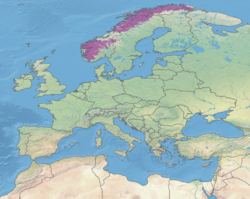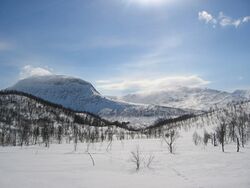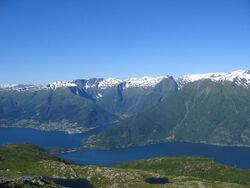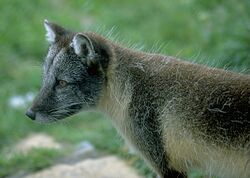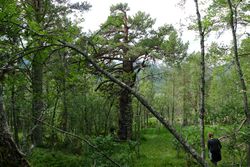Place:Scandinavian Montane Birch forest and grasslands
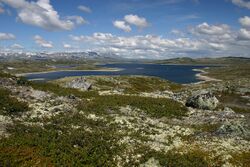
The Scandinavian Montane Birch forests and grasslands ecoregion, a Palearctic ecoregion of the Alpine tundra and Boreal forest Biomes, located in Norway , Sweden, and Finland . It is one of the terrestrial ecoregions determined and defined by the World Wildlife Fund.[1]
Conservation value
The Scandinavian Montane Birch forests and grasslands is one of the Global 200 ecoregions, and is thus regarded as a high priority for conservation.
Geography
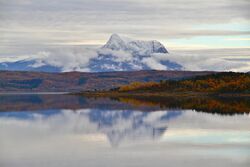
The ecoregion follows the Scandinavian Mountains, and spans 11 degrees of latitude from the south to the north. About two-thirds of the ecoregion is located in Norway , about one-third in Sweden and a small area touches the northwesternmost part of Finland . This is a varied ecoregion, 1,600 km long, with a total area of approximately 243 000 km2 (slightly larger than Great Britain).[2]
The largest glaciers on the European mainland are located here (Jostedalsbreen, Svartisen), as are Northern Europe's highest mountains (Jotunheimen) and largest mountain plateau. The mountain chain itself creates a rain shadow, and the eastern part of the mountain chain is considerably drier than the western part. The ecoregion is divided in two parts, the southern part is in Norway's central mountains and goes down to the western fjords. The northern part follows the Kjølen mountains, and also goes down to the fjords in the west. The western part of the ecoregion, both in the south and north, borders on the Scandinavian coastal conifer forests ecoregion or directly on the fjords (Norwegian Sea and North Sea). The eastern part of the ecoregion, both in the south and the north, borders on the Scandinavian and Russian taiga ecoregion. In the far south it meets the Sarmatic mixed forest ecoregion, while the extreme northeasternmost part near the Barents Sea bordes on the Kola peninsula tundra ecoregion.
Habitats
Parts of the ecoregion are located in smaller mountain areas surrounded by lower elevation biomes, as is the case with coastal mountains in Norway. At the highest altitude is high alpine tundra with very modest vegetation and bare rock, skree, snowfields and glaciers. At lower altitude is low alpine tundra with continuous plant cover; dwarf birch and willows up to 1 m tall and grasslands, as well as numerous lakes and bogs. At still lower altitude is the adjacent montane birch zone with small (2–5 m) mountain downy birch (Betula pubescens) above the conifer tree line; some stunted spruce and pine, and many lakes and bogs. This part is regarded as part of the High boreal (sparse taiga) vegetation zone; birch forming the treeline is very rare outside Scandinavia (also in Iceland and the Kamtchatka peninsula).
At still lower elevations the forests become closed-canopy (mid-boreal, south-boreal), denser and taller (8–20 m, exceptionally 30 m) with more species including mature Scots pine and aspen. Sometimes much of the lowland forest near the fjords of Western Norway is also included as Norway spruce is mostly absent here (both Norway spruce and Sitka spruce are commonly planted for economic reasons). In these temperate forests are also species such as Quercus robur, Fraxinus excelsior, Taxus baccata, holly and small-leaved linden in addition to pine, aspen and birch. There might thus be a very large span in environmental conditions within this ecoregion; from temperate forest near the fjords with a 6-month growing season to the highest mountains with glaciers and snowfields not melting until mid-summer.
Flora and fauna
Flora: There are many alpine plant species in this region not found anywhere else in Europe, but often in the Arctic and sometimes in mountain areas in North America. In addition to birch trees include aspen, Scots pine, Juniperus communis, grey alder, rowan, goat willow and bird cherry. Some of the characteristic herbst are Aconitum lycoctonum, bilberry (blueberry) and Rubus chamaemorus, the latter typically growing on the numerous bogs.
Fauna includes predators like wolverine, brown bear, Eurasian lynx, grey wolf, red fox and stoat. The Arctic fox is in danger of extinction in this area, but there are efforts to try to save the species. Herbivores include wild reindeer (only in the mountains in central Norway; the reindeer in the north are semi-domesticated), roe deer and red deer (lowland in southern part of ecoregion); the most common large herbivore is the moose (mostly below the treeline). Lemming, voles, squirrel and hare are common, and the European otter is common near the fjords and in many rivers, especially in the north. There are approximately 150 musk oxen on Dovrefjell, having been transported from Greenland in the 1930s, as the species were extinct in Scandinavia.
There is a rich bird life; most birds are migratory, but some, like the ptarmigan, stay all year. Bird species include gyrfalcon and sea eagles. There are many lakes with trout and Arctic char, the rivers have sea trout and salmon.
See also
- Boreal forest
- Subalpine zone
- Alpine tundra
- Altitudinal zonation
- Scandinavian coastal conifer forests
- Scandinavian and Russian taiga
- Sarmatic mixed forest
- Vegetation of Norway
References
- ↑ "Scandinavian montane birch forest and grasslands". Terrestrial Ecoregions. World Wildlife Fund. http://worldwildlife.org/ecoregions/pa1110.
- ↑ World Wildlife Fund, ed (2001). "Scandinavian Montane Birch forests and grasslands". WildWorld Ecoregion Profile. National Geographic Society. Archived from the original on 2010-03-08. https://web.archive.org/web/20100308064632/http://www.nationalgeographic.com/wildworld/profiles/terrestrial/pa/pa1110.html.
- ↑ "Archived copy". Archived from the original on 2012-07-17. https://archive.is/20120717012402/http://retro.met.no/observasjoner/sogn_og_fjordane/normaler_for_kommune_1418.html?kommuner. Retrieved 2012-01-15.
- ↑ http://www.yr.no/sted/Norge/Sogn_og_Fjordane/Vik/Vangsnes_målestasjon/statistikk.html
External links
